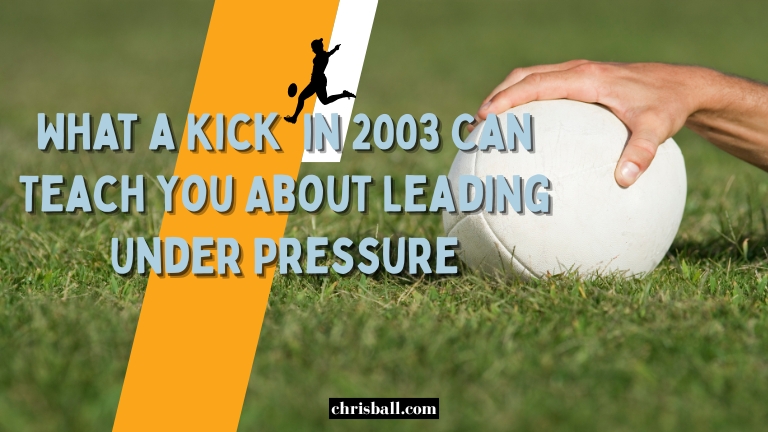Think back to 2003. England faced Australia in the Rugby World Cup final, and millions of people were glued to their screens. Extra time. Scores level. Pressure so heavy you could almost hear hearts pounding through the television. Then, with composure most of us can’t manage even when making a simple parking manoeuvre, Jonny Wilkinson calmly slotted the winning drop goal. History made.
But here’s the truth: the victory wasn’t just about Wilkinson’s boot. It was about years of leadership, planning, and belief. Sir Clive Woodward’s leadership philosophy brought that team to the point where they could deliver in those final seconds. And it’s not just a story about sport—it’s a masterclass in how leadership works in business, careers, and life.
Vision That Doesn’t Waver
Woodward didn’t lead with vague “let’s win stuff” slogans. He had a clear vision, built around not only winning but also developing the skills, resilience, and confidence needed to perform under pressure. Every training session, every strategy meeting, every uncomfortable conversation reinforced that vision.
Think about your own team—or even your own goals. Do you know what you’re working toward, or are you just reacting to the week’s chaos? Without a vision, you’re playing blind. With one, even gruelling tasks feel purposeful.
The Process Matters
Here’s where Woodward stood out. He didn’t just focus on outcomes; he cared about the process. He understood that enjoyment wasn’t about making training easy—it was about making the challenge itself rewarding. Hard work could still be fun if the players felt engaged, valued, and trusted.
In business, too many leaders ignore this. They push for deadlines, metrics, and profit but forget that people need to enjoy the grind. Not in a “bring cupcakes to the meeting” way, but in a deeper sense: feeling proud of their work, stretched by challenges, and connected to the team’s mission.
Ask yourself: do you enjoy the journey, or are you waiting to “enjoy life” only once you’ve ticked off some milestone?
Staying Calm in the Storm
The 2003 final was brutal. Both teams were exhausted. Mistakes could have unravelled everything. But England held their nerve. That calmness under pressure wasn’t accidental—it was drilled into them through relentless preparation and mental conditioning.
Leadership is tested most when the storm hits. Anyone can “lead” when the sun is shining. The question is: when things get tough, do you lose your head and spread panic, or do you hold steady and give your team confidence?
In your workplace, people aren’t waiting for motivational speeches—they’re watching how you act when things go wrong. Your response sets the tone more than your words ever will.
Trust That Runs Both Ways
One of Woodward’s greatest strengths was trusting his players. He gave them ownership of their training and space to contribute ideas. This wasn’t a dictatorship—it was a partnership. By the time they reached the World Cup, players weren’t just following orders; they were co-creators of the game plan.
Trust works the same in business. Micromanaging kills initiative. But giving people ownership sparks engagement. Do you treat your team like robots ticking boxes, or like partners in achieving something meaningful? The difference decides whether you end up with passive compliance or active commitment.
Turning Pressure Into Purpose
Wilkinson’s kick was iconic, but it was only possible because the team had turned years of pressure into confidence. They didn’t see the moment as unbearable; they saw it as the chance they had prepared for. That’s the shift great leadership makes.
What about you? How do you handle high-stakes decisions? Do you freeze up, waiting for perfect conditions, or do you lean on preparation and make the call? Leaders who consistently prepare their teams for tough moments find that when the crunch comes, people rise rather than crumble.
From Rugby Fields to Boardrooms
The leap from rugby pitches to boardrooms isn’t as big as it looks. The lessons carry over:
- Set a clear vision. Know what you’re aiming for and communicate it constantly.
- Make the process engaging. Hard work should stretch people but still feel rewarding.
- Prepare for storms. Don’t avoid pressure; train for it.
- Build trust. Share ownership and empower people to lead in their own roles.
- Keep purpose alive. Remind people why the struggle is worth it.
When you lead this way, results follow. They may not always come as dramatically as a drop goal in extra time, but they’ll come. And they’ll come with a sense of shared pride and satisfaction that makes all the effort worth it.
Your Leadership Game
So here’s the question: what’s your equivalent of the Rugby World Cup final? Maybe it’s a business pitch, a personal project, or a tough transition in your career. Whatever it is, your ability to succeed won’t come down to luck in the moment. It will come from the leadership habits you build now.
Are you setting a vision your team (or even your family) can believe in? Are you making the process meaningful? Are you cultivating trust, so when the pressure is on, people stand tall instead of backing away?
These are the kinds of questions explored in Winning The Game. It’s not a book about working harder or chasing success with a grim face. It’s about leading with purpose, enjoying the journey, and creating results that actually feel like victories.
Leadership is not about a single heroic act. It’s about the small conversations, daily habits, and consistent choices that make those heroic acts possible when the spotlight is on.
England’s victory in 2003 wasn’t luck. It was leadership in action. And your next victory—whether in work, life, or something personal—will come from the same place: vision, trust, and the willingness to enjoy the process while chasing something bigger than yourself.
